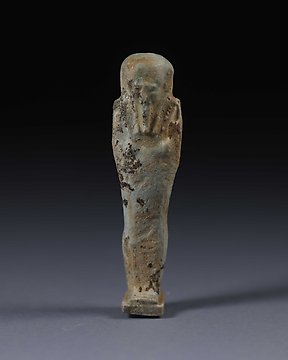
Égypte ancienne Ouchabti - 10 cm
Nº 83776959

Nº 83776959

Sculptor's Model in the Shape of a Foot.
Ptolemaic Period 332-30 BC.
Hardened limestone.
Length 15 cm and height 7.5 cm.
PROVENANCE: Private collection of G.L., Schleswig-Holstein, Germany. Acquired prior to the 1970s.
CONDITION: Good state of preservation, no restorations.
DESCRIPTION:
The sculptor's models are rectangular plaques and round sculptures of small format, between thirty and eight centimetres in height, sculpted in white limestone and with a common characteristic: an unfinished appearance. These were test or study pieces, intended to improve the sculpting technique of the apprentice in the trade.
Egyptian round sculptures are mainly heads or busts of royal personages, although a small number of busts representing private individuals or deities have also been found, and others are only profiles. In addition to heads, there are numerous models of feet, in most cases the left one, presumably because in Egyptian statuary this foot, together with the leg, is advanced in a marching attitude, and is therefore more visible. Hands, arms, legs and, to a lesser extent, torsos are also sculpted to a very realistic degree. Likewise, there are also animals or parts of animals (especially front parts), as is the case with the lion: the head of this animal was used during this period of Greek domination as a decorative architectural element, an example of which are the two heads located on the back wall of the temple of Dendera. But others such as the ram, bull, monkey, cat, horse and falcon are also included.
Among the reliefs used as sculptor's models we find a greater variety of examples. Again, royal personages are predominant, heads, busts and almost complete figures; but individual forms of hieroglyphs, animals and birds are equally common. There is also a selection of private personages, deities - most are profiles of female goddesses with vulture crowns - sacred symbols and body parts. In many cases, where only the head of an animal is shown, it is intended to represent the deity with which it is associated, a fact evidenced by the addition of human shoulders, or by the wig covering the mane or by an extra set of horns on the head, as in the relief image with the head of the ram god Khnum. This leads us to see in other animal reliefs divine representations where there are no human elements, only animals.
No Egyptian work is ever left in an incomplete state unless it is expressly so; they are always finished. In this typology of models, we can see some with a wider and more rectilinear chiselling, delimiting the forms, and others in which the chisel marks are not found, but the surface is not perfectly smooth and polished. In the majority of busts representing a pharaoh, vertical and horizontal marks can be seen, especially on the back and sides, used by the craftsmen to delimit the different parts of the face in a grid in order to achieve symmetry. In Egyptian art these grids, whether on reliefs or sculptures, are made with red or black paint to outline the proportions of the figure in accordance with the canon used in this period, and are then erased, with only the finished result being visible. There are short lines marking the location of individual features such as eyes, nose, mouth, chin... in many examples these marks are depicted on the backs or sides, in order to be able to be guided at the moment of frontal sculpting. In these real representations in particular, these squares are incised and have not been removed, thus allowing their modelling to be seen. This is the clearest evidence of the pedagogical nature of the work. Another evidence is the absence of painted examples. A limestone sculpture was usually polychromed, and there is no evidence of any painting on these carvings. Not even to mark the lines of expression on the faces and hide the subtleties of the carving, the sculptor does not polychrome it to observe his work, his strokes, his hand. This is the clearest example showing that these works were intended to train a student or serve as a model for them.
For the Egyptians, the representation of an object or an entity, on any medium, gave it life and it was identified with the real object or person. This fact meant that they would never leave a work unfinished, unless it was for a specific reason, such as this one, in which they were carried out as practice in order to be able to sculpt to such a degree of perfection that they were considered true sculptors.
BIBLIOGRAPHY:
TOMOUN, Nadja. The Scuptors' models of the Late and Ptolemaic Periods. A study of the type and function of a group of ancient egyptian artefacts. National Center for Documentation of Cultural and Natural Heritage. Supreme Council of Antiquities. Cairo, Egypt. 2005.
Notes:
- The piece includes authenticity certificate.
- The piece includes Spanish Export License.
- The seller guarantees that he acquired this piece according to all national and international laws related to the ownership of cultural property. Provenance statement seen by Catawiki.
Comment acheter sur Catawiki ?
1. Découvrez des objets d’exception
2. Faites la meilleure offre
3. Effectuez un paiement sécurisé